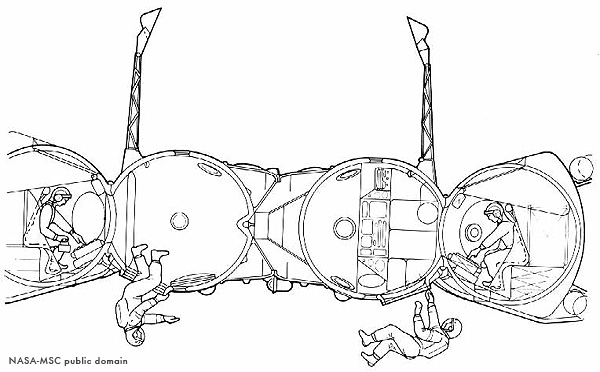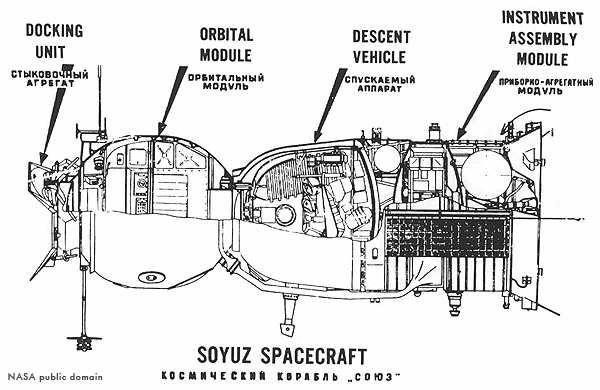
I have a theory about the origin of the Spacex Soyuz 6 and 7 toys: I think they're actually based on Soyuz 4 and 5. During their mission in January 1969, these two Soviet spacecraft performed the first ever docking in space, as well as the first crew transfer (NASA would follow two months later during the Apollo 9 mission). The Soviet crew transfer was done through a space walk, since the docking mechanism didn't include an airlock (which Apollo 9 did have), and has remained unique ever since.

Illustration showing the EVA between Soyuz 4 and 5, by W M Taub at NASA-MSC, 1969.
Since the space race was in full swing while the Pippin Spacex range was being developed, I believe that it must've been decided to designate the toys with the next Soyuz numbers, 6 and 7, to make them appear more actual by the time they were introduced on the market in early 1970.
The real Soyuz 6 and 7 were launched in October 1969 together with Soyuz 8. From what I read on Wikipedia (1), the objective of this mission had been that Soyuz 6 would film the docking of Soyuz 7 and 8. Since Soyuz 6 and 7 weren't meant to dock together, I believe the Spacex toys will have been named (and packaging produced) before details of the mission will have been known. And as events turned out, the docking of Soyuz 7 and 8 failed due to technical reasons. Which prompted the Soviets to subsequently deny that a docking had been planned at all, to the point of not even carrying spacesuits to do so. Other than formation flying and ground stations having to track three separate spacecraft, the mission's most notable experiment was testing three different types of welding equipment in space. Welding was seen as preferable to fixing structures by nuts and bolts (tricky in 0 gravity), and a spacesuited welder was actually depicted in the Soyuz 6 mission patch.
The Soyuz (the name means "Union" in Russian) and its rocket have the distinction of being the longest-serving spacecraft type in history (2), still in use today to ferry men and materials up to the International Space Station. It existed in a number of versions and developments (the early ones being type 7K-OK (3)), but all are essentially the same craft.

Main Soyuz modules, shown here on Soyuz 19 (type 7K-TM) which docked with a US Apollo spacecraft in 1975 using a different docking unit. The Descent Vehicle in the middle is the part that returns to Earth, having a heat shield at the rear for re-entry. The solar panels are shown folded next to the Instrument Assembly (Service) Module. The latter also houses the oxygen and fuel supplies, the heating system, electronics, communication and control equipment as well as the attitude control thrusters at the rear. Soyuz 19 did not have the large radar mast (used with the earlier Igla automatic docking system (4)) that is distinctively present on the Spacex toys.
To close off, here's a contemporary Soviet documentary on Soyuz 4 and 5, called чеmверо в космосе (Four in the Cosmos in Russian).
External links open in new windows
Note: comparison photo shows two docked Soyuz craft on display at the 1971 Paris Air Show - from the Observer's Book of Manned Spacecraft, first published 1972. A contemporary report on this exhibit can be read in Flight magazine's archive (note these are pdf files, which your browser may download instead).
1): Wikipedia has entries on Soyuz spacecraft and a list of missions linking to individual pages. OrbitalHub has a page on the Soyuz 4 and 5 mission. back to text
2): David Portree has written an excellent overview of Soviet space hardware, accessible from the Johnson Space Center server (again a pdf file, which your browser may download instead). back to text
3): Of course, Mark Wade has extensive information on his outstanding Astronautix.com. back to text
4): Sven Grahn has a detailed page on how the Igla system worked. back to text